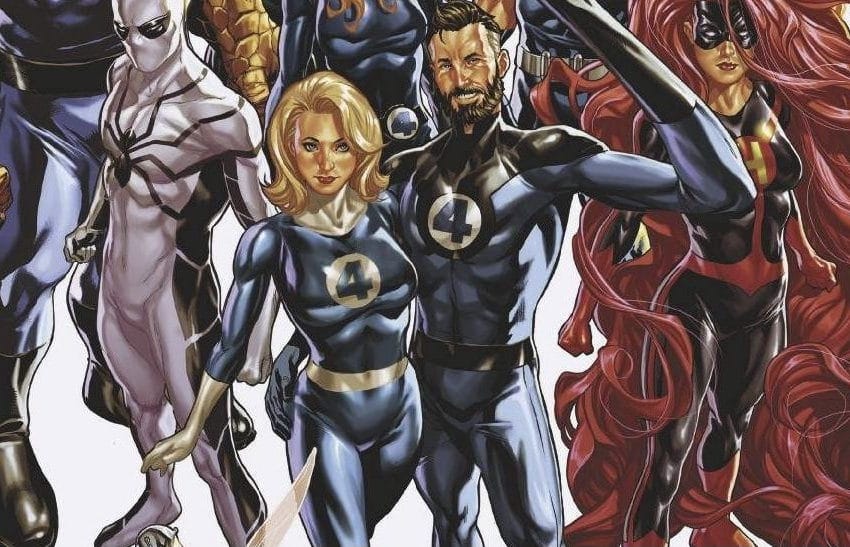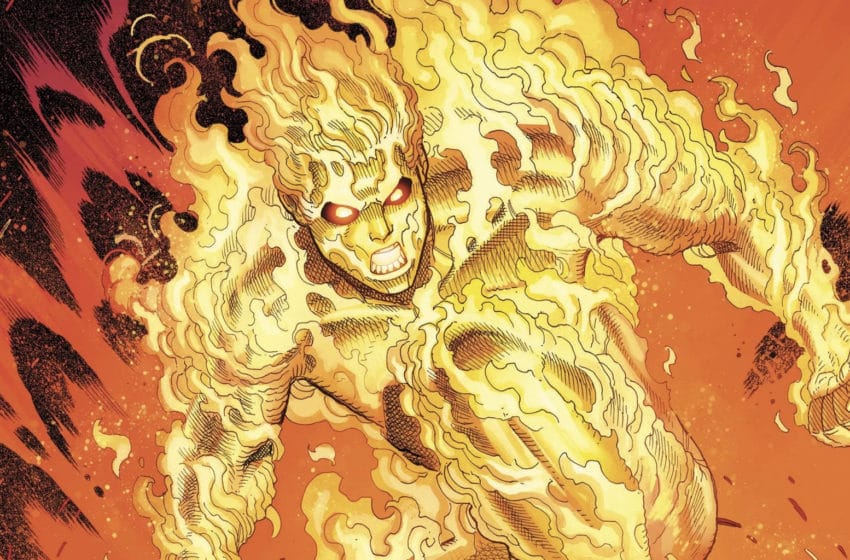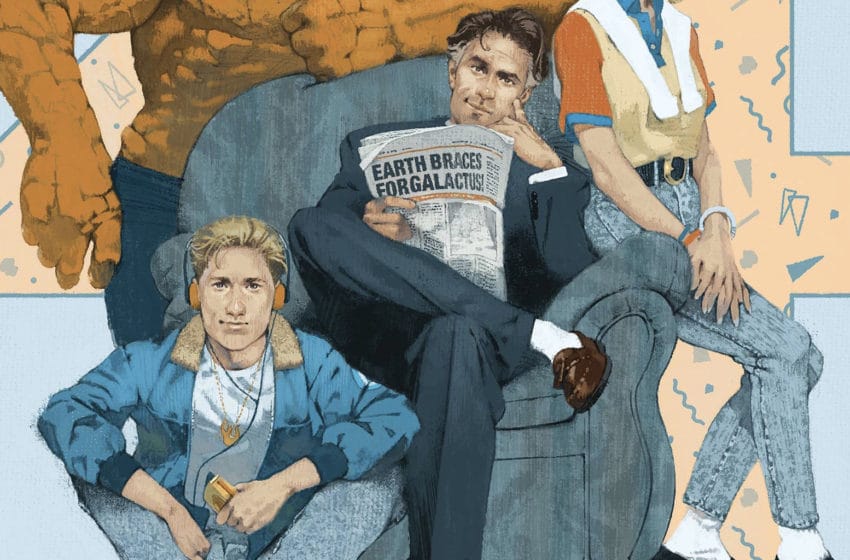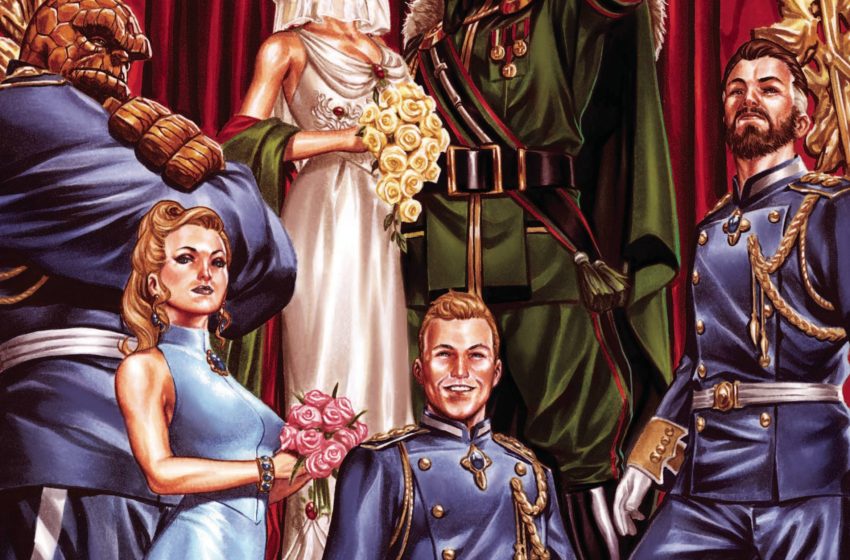Kang throws the FF an anniversary bash from beyond the veil of time in Fantastic Four #35. Written by Dan Slott, Jason Loo, and Mark Waid; Drawn by John Romita Jr, Jason Loo, and Paul Renuad; Inked by JP Mayer, Scott Hanna, Cam Smith, Rafael Fonteriz, and Mark Morales; Colored by Marte Gracia & Erick Arciniega; Lettered by Joe Caramagna
Conceptually and presentationally, there is a lot to love about Fantastic Four #35. The idea of a bunch of petty and sniping Kangs getting together and making supervillainy into a reality show competition is genuinely a really fun idea. A fun that is further boosted by the issue’s presentation, delineated by fake cover page splash pages peppered throughout the main action. All period accurate to the time and chock full of fun Marvel easter eggs to other books that presumably held the shelves alongside these “lost” FF covers.
Unfortunately, like most “big” stories like this from Dan Slott, there is still no real spark to Fantastic Four #35’s main story beyond a few sweet character beats. Bouncing from the “present day” team through the early years of the FF, the Tom DeFalco era, and even Jonathan Hickman’s tenure with the title (specifically Fantastic Four #605 “End of Line”, the issue first introducing Nathaniel’s “Prize”) Fantastic Four #35 just feels big for bigness’ sake. Like it’s just going through the motions in order to deliver an “appropriately” large scale and heady anniversary issue. All while awkwardly getting us and the FF cast ready for the incoming Reckoning War. And not dealing much at all with the title’s ongoing running plots like the Baxter Building remodel and Johnny’s new constant nova-flame status.
Part of me understands it. This is a big legacy numbered title, heralding another pretty significant anniversary. How do you try to pay tribute to that and wrestle with the title’s future in the text? You could play with a few noteworthy tenures (though I think the DeFalco shoutouts might just be Slott’s inclination as there is a lot of that run in his run too) and you try to mine at what made the lasting appeal of the book a thing in the first place.
For Slott that appeal appears to be the Huge Ideas and Family Moments. The latter actually gets a lot of love right here in #35. Most of the vignettes are centered and resolved through some sort of connection between the family members. And that stuff works! Unfortunately that same heart is dragged down by the lack of truly engaging plotting. Sure, it seems “big” and “mind bending” on the surface and is spruced up with all sorts of crunchy, detail-oriented “technobabble” to make it seem like even the “impossible” science has some sort of ethos. But it just never seems to fully get off the ground. Like it’s just trying to convince you, the reader (and itself maybe) that this is “Big, Important Stuff” because everyone is saying big words and operating within the skeleton of a “laid out” time travel story spanning across millions of years (and famous/infamous comic book events).
It doesn’t exactly help matters either that the main action is rendered by John Romita Jr, backed by a full bench of inkers and two colorists. Occasionally he finds some burly energy in the fight scenes. The impromptu Triple Threat match between the Onslaught Era FF, The Thunderbolts (née Masters of Evil), and the Scarlet Centurion especially is a standout sequence. But overall everything is far too blocky and non-emotive. A blockiness that is instantly apparent in the more expository scenes. Further throwing cold water on all the big turns of plot and high drama Slott’s script is aiming for.
Helping matters even LESS is the truly stellar back-up stories Fantastic Four #35 comes complete with. Stories that do the precise things the main story tries to do, but just in a far shorter page count. I know that might sound counterintuitive, saying that two good stories don’t actually help the issue overall, but they absolutely do cast a bad comparative light on the main action. Simply because it lacks the dynamism, visual pop, and narrative drive of these two back ups. Jason Loo’s “Some Family Time” is a madcap and wonderfully presented look at what happens when the Richards Family tries to have a “chill family day”. While Waid and Renaud’s “Stars” explores, with devastating pogiancy, Reed’s mindset in the days after their fateful flight and his hubris that leads them there. That he wanted the world to see his friends how HE saw them; as real heroes.
Ultimately Fantastic Four #35’s most damning crime is that it makes you want to read other Fantastic Four comics. Yes, it’s a technically functional issue and occasionally even flirts with a few flat-out great moments connected by a novelly fun framing device. Plus it comes armed with two impressive backup stories that are sure to send readers and FF superfans out on a high note sustained by what makes the Fantastic Four work in the first place.
But Fantastic Four #35 by in large feels and reads too rote, too wooden, to ever feel like a proper anniversary celebration of one of Marvel’s most enduring legacy teams. It seems to simply exist to keep THEM existing in current continuity. A fate beneath Marvel’s First Family and one worse than cancellation outright.
Zachary Jenkins runs ComicsXF and is a co-host on the podcast “Battle of the Atom.” Shocking everyone, he has a full and vibrant life outside of all this.






